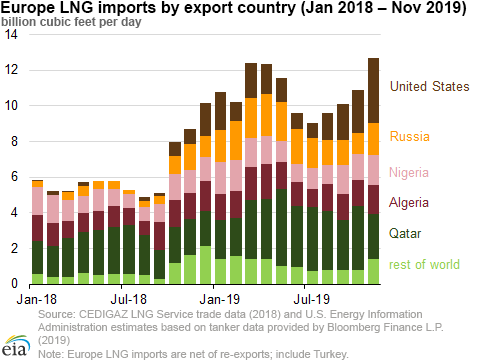European LNG Imports at Record
Europe’s imports of liquefied natural gas (LNG) reached a new monthly record of 12.7bn ft/d³ last month, according to the US Energy Information Administration (EIA), based on Bloomberg Finance shipment data. This monthly record implies a 51% utilisation of Europe-wide regasification capacity, including Turkey.
From January through November 2019, LNG imports into Europe averaged 11bn ft³/d – the highest level for European LNG imports – surpassing the previous record of 8bn ft³/d annual average) set in 2011. Lower spot LNG prices in Asia have narrowed the price differentials between delivering LNG to Asia or to Europe and have contributed to increased cargo shipments to Europe, said the IEA.
LNG imports into Europe have been relatively low in recent years. This year, however, spot natural gas prices in Europe declined to a 10-year low, providing incentives for gas-fired power generation, especially in Germany and Spain. Gas output is declining in the UK and the Netherlands and this required larger volumes of natural gas imports by both pipeline and as LNG. Lower natural gas demand in Asia has freed up more destination-flexible LNG cargoes that were shipped to Europe, said the EIA.
This year, three LNG suppliers – Qatar, US and Russia – have increased their LNG exports to the region by a combined 3.7bn ft³/d in the first 11 months of 2019 compared with last year, and the US accounted for the biggest increase, with LNG exports growing from 0.4bn ft³/d in 2018 to 1.8bn ft³/d in the first 11 months of 2019, followed by Russia (1.3bn ft³/d increase), and Qatar (1.0bn ft³/d increase). Other suppliers to Europe, including Nigeria, Trinidad & Tobago, and Algeria, increased LNG exports by 0.3bn ft³/d each in 2019 (January–November) compared with the annual average for 2018.
Major Asian LNG consumers Japan, China, South Korea, and India, which account for 65% of global LNG imports in 2018, imported an estimated 26.1bn ft³/d of LNG between January and November 2019.
In Japan, natural gas consumption was affected by lower demand for natural gas-fired generation following the restart of five nuclear reactors and increased generation from renewable sources, particularly solar. Similarly, in South Korea, LNG imports decreased as a result of higher generation from nuclear units, several of which were restarted in 2019 after an extended maintenance period last year. Renewables were also up while electricity demand was lower.




